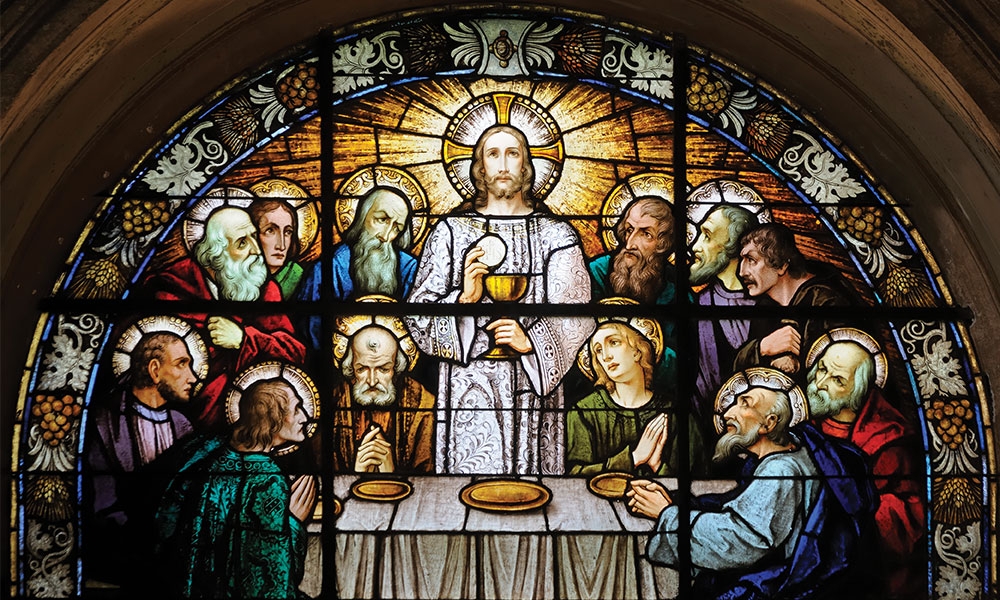
Why believe in the Real Presence?
Biblical foundations of the Church’s Eucharistic beliefs
Biblical foundations of the Church’s Eucharistic beliefs
Inspired by the mission of the National Eucharistic Revival, this column presents an accessible catechesis on the Eucharist to help readers encounter Jesus in the Blessed Sacrament and become his faithful witnesses in the world.
Shortly after she converted to Catholicism, 20th-century American writer Flannery O’Connor attended a dinner party in which another guest described the Eucharist as a “pretty good” symbol. O’Connor recalled:
I then said, in a very shaky voice, ‘Well, if it's a symbol, to hell with it.’ That was all the defense I was capable of but I realize now that this is all I will ever be able to say about it, outside of a story, except that it is the center of existence for me; all the rest of life is expendable.
Inspired by the mission of the National Eucharistic Revival, this column presents an accessible catechesis on the Eucharist to help readers encounter Jesus in the Blessed Sacrament and become his faithful witnesses in the world.
Shortly after she converted to Catholicism, 20th-century American writer Flannery O’Connor attended a dinner party in which another guest described the Eucharist as a “pretty good” symbol. O’Connor recalled:
I then said, in a very shaky voice, ‘Well, if it's a symbol, to hell with it.’ That was all the defense I was capable of but I realize now that this is all I will ever be able to say about it, outside of a story, except that it is the center of existence for me; all the rest of life is expendable.
As O’Connor later realized, her pithy response was eminently logical. The Eucharist, when correctly understood, becomes the axis on which one’s whole life (and the universe itself) turns. And there is nothing logical about ordering one’s life around a symbol.
But this begs the question: Was what O’Connor believed about the Eucharist true? Recall the radical Catholic claim: After the priest pronounces the words of consecration at Mass, the bread and wine, despite retaining the appearances of bread and wine, become the body, blood, soul and divinity of Jesus Christ. This is the doctrine of transubstantiation. This is what Flannery O’Connor believed.
Protestant denominations profess a range of attitudes toward the Eucharist; some affirm a version of the “Real Presence” in which Christ is “spiritually” but not bodily present; others, such as O’Connor’s interlocutor, believe the Eucharist is only a symbol of Christ.
In this column, we’ll respond to the all-important question: Why do Catholics assert that Jesus is really, substantially, present – not just spiritually – in the Eucharist?
To that end, we’ll examine the biblical foundations for the Church’s doctrine of transubstantiation. Although we’ll barely skim the surface, what is most important is that the reason for the Church’s belief in the real, substantial presence of Jesus in the Eucharist is that Jesus himself wanted us to believe it, and taught it by his words and actions.
The disciples took him at his word
Approximately a year before he spoke the familiar words, “This is my body,” at the Last Supper, Jesus preached a sermon which was doubtlessly meant to help his disciples (and us) make sense of the reality of his Eucharistic presence later on. “I am the bread of life,” he said to the crowd gathered at the synagogue in Capernaum. (Jn 6:35) When his listeners murmured with confusion and disbelief, Jesus repeated:
I am the living bread which came down from heaven; if anyone eats of this bread, he will live for ever; and the bread which I shall give for the life of the world is my flesh. (Jn 6:51)
The crowds murmured again, but Jesus didn't attempt to pacify them by suggesting that he was only speaking metaphorically. Instead, he doubled down:
Truly, truly, I say to you, unless you eat the flesh of the Son of man and drink his blood, you have no life in you; he who eats my flesh and drinks my blood has eternal life … For my flesh is food indeed, and my blood is drink indeed. (Jn 6:53-55)
It is difficult for a modern reader to fathom how abhorrent these words would have been to the ancient Jewish ear. God himself had forbidden the consumption of animal blood multiple times in the Law of Moses. Apart from that, what Jesus was asking sounded like cannibalism!
“This is a hard saying,” his disciples responded. “Who can listen to it?” (Jn 6:60) They clearly took him literally, so this would have been the ideal time for Jesus to do damage control. But instead, he allowed a large number of his followers to leave (Jn. 6:66). Acceptance of his command – “unless you eat the flesh of the Son of man and drink his blood, you have no life in you” – had become a condition of discipleship.
Jesus knew his audience
Although he intended the Gospel to reach every corner of the earth, Jesus’ ministry was primarily among the Jewish people. Many of his words contain explicitly Jewish references which Jesus knew his audience would understand. Listening with a Jewish ear, therefore, can help us discern what Jesus intended listeners to infer. Although a hundred columns would not be enough to exhaust this topic, we can learn much about the meaning and reality of the Eucharist by examining a single Jewish custom: the feast of Passover.
The new Passover
The Church has believed in the real presence of Jesus in the Eucharist for 2,000 years because her first members were Jewish – and therefore, they understood much more easily the Jewish meaning of Jesus’ actions. The disciples present at the Last Supper would have traveled to Jerusalem each year at Passover, the annual celebration of God’s deliverance of his people from slavery in Egypt. They would have witnessed the sacrifice of the Passover lambs in the temple and would be familiar with the ritual of the Passover meal.
It was the time of Passover when Jesus gathered his disciples in the Upper Room on Good Friday. The meal they shared was a Passover meal. But in place of a lamb, Jesus “took bread” (Lk 22:19) and offered an explanation which was akin to, but radically different from, the typical lesson a Jewish father would have given to his family as part of the ritual.
[A]nd when he had given thanks he broke [the bread] and gave it to them, saying, “This is my body which is given for you.” (Lk 22:19)
There would have been little doubt in any of the disciples’ minds that Jesus, somehow, intended to take the place of the unblemished lamb of sacrifice.
But, we might still object, could he have been speaking only symbolically?
First, it is important to understand that, in the Jewish mind, the Passover observance was much more than a “looking-back” at past events. It also involved a mystical, but nevertheless real, “making-present” of those events. Passover was not only a celebration of God’s deliverance of his people from Egypt more than 13 centuries before; it was also the accomplishment of his deliverance here and now.
If the ritual celebration of the original Passover, instituted and commanded by God himself, was that powerful, wouldn’t the ritual celebration of the new Passover be even more powerful? After all, the words of God Incarnate, “Do this in remembrance of me” (Lk 22:19), were an explicit command to repeat his actions. “In the future,” Jesus’ words implied, “the deliverance from slavery to sin that I will accomplish tomorrow on the cross will be made a present reality for you whenever you fulfill this commandment.”
Notably, that present reality would be substantial, corporeal. As any ancient Jew would have known, the Passover lamb was not simply killed; it was eaten. Thus, in order to fulfill the requirements of the New Passover, the family of God would likewise need to consume the Lamb. And this would be possible only if Jesus’ words a year earlier in the synagogue at Caupernaum – “my flesh is food indeed, and my blood is drink indeed” – had become reality.


